In the history of the NHL, there have been 194 times a player has scored 50-goals in a season. The feat was achieved by 91 different players. Mike Bossy and Wayne Gretzky top the list; each had nine 50-goals seasons
Only once have two

Bernie Nicholls (nhl.com) 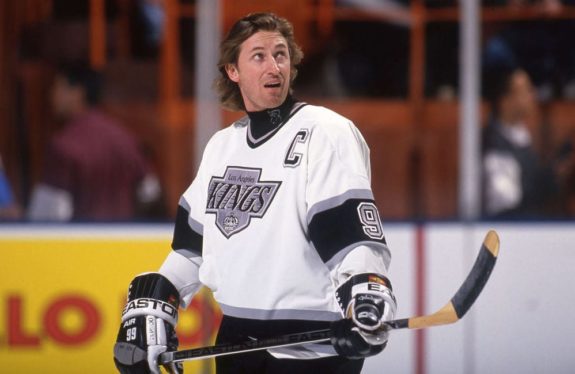
Wayne Gretzky (Photo By Andrew D. Bernstein/Getty Images)
Can the Toronto Maple Leafs’ John Tavares and Auston Matthews be the first duo to repeat the two-centre 50-goal scorer act?
History of Teams with Multiple 50-Goal Scorers
On 24 occasions two players on the same team scored 50-plus goals in the same season; 18 times they were linemates. The remaining six featured two 50-goal scorers on different lines. Only once did they both play
The 1970-71 season was the first time two players on the same team scored 50 or more goals. It was the Boston Bruins’ centre Phil Esposito (76G) and winger Johnny Bucyk (51G). Three years later, the Bruins’ Esposito (68G) did it again with Ken Hodge (50G). They were linemates.

John Bucyk (THW Archives 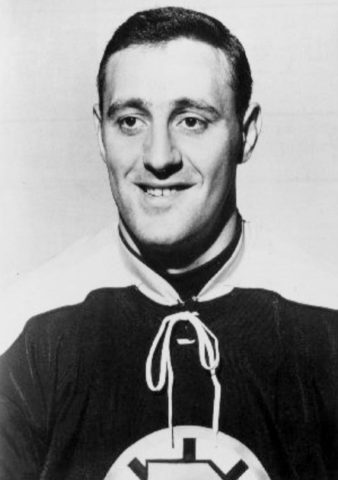
Phil Esposito (Wikimedia Commons)
The 1983-84 Edmonton Oilers had three players reach the 50-goal plateau, Gretzky (87G), Glenn Anderson (54G), and Jari Kurri (52G). The three of them did it again in 1985-86. Gretzky was the only centre.
The NHL’s 1983-84 season began the longest consecutive string of six seasons where at least one team had multiple 50-goal scorers. The string ended with the 1988-89 season when the Kings’ two centres, Nicholls and Gretzky, shared the honor with the Calgary Flames’ Joe Nieuwendyk (51G) and Joe Mullen (51G). Mullen was a winger.
After three seasons of hiatus without a team having multiple 50-goal scorers, it occurred again in the 1992-93 season when three teams celebrated the achievement. The Buffalo Sabres had winger Alexander Mogilny (76G) and centre Pat LaFontaine (53G). The Pittsburgh Penguins had centre Mario Lemieux (69G) and winger Kevin Stevens (55G). The St. Louis Blues had Brett Hull (54G) and the Brendan Shanahan (51G), both wingers.
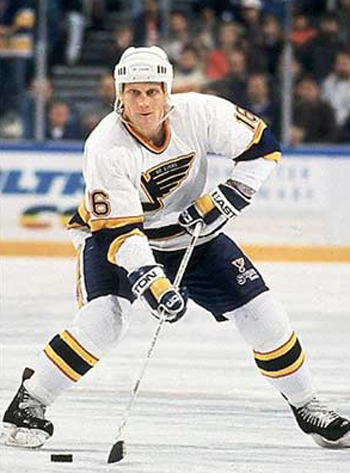
Brett Hull (David E. Klutho/Sports Illustrated) 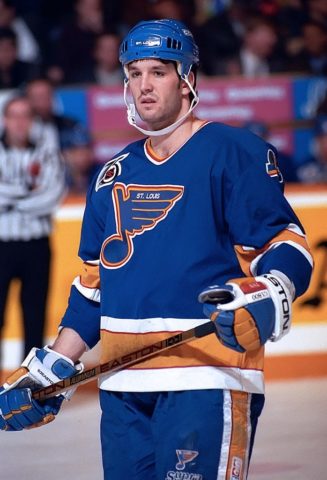
Brendan Shanahan (Photo by Graig Abel Collection/Getty Images))
In the 1992-93 season, the Maple Leafs had one player reach the 50-goal mark. Dave Andreychuk was acquired from the Sabres on Feb. 5. Had Andreychuk remained with the Sabres, he may have joined Mogilny and LaFontaine to make it three 50-goal scorers.
The last time the NHL saw a team boast multiple 50-goal scorers was the 1995-96 season. The Penguins did it with Lemieux (69G) and Jaromir Jagr (62G), a centre and a winger, respectively.
A Historical look at a 50-Goal Scorer’s Season
Using the entire population size of 194 times a player has had a 50G season, the average goals per game is 0.72. A player today would have to score an average of 0.61 per game to net 50.
Related: The 50 Goal Season
The season average of power play goals scored by a 50-goal scorer is 17.3. On average, power play goals scored by a 50-goal scorer represents 31 percent of their goals scored. Based on the historical percentage, a player today would tally 16 power play goals in a 50-goal season.
Since the average time on ice statistic began in the 1997-98 season, a player has scored 50-goals 30 times. The ATOI was 22 minutes and 28 seconds (22:28). This can be used as a benchmark for players today.
A 50-goal scorer has averaged 302 shots per season. A player today would need 3.68 shots per game to achieve a total of 302 shots.
Comparing Tavares & Matthews to 50-Goal Scorer Benchmarks
The historical look at a 50-goal scorer’s season established benchmarks for assessing a potential 50-goal scorer. The benchmarks are compared to Tavares and Matthews’ current season to demonstrate how close they are to achieving a 50-goal season.
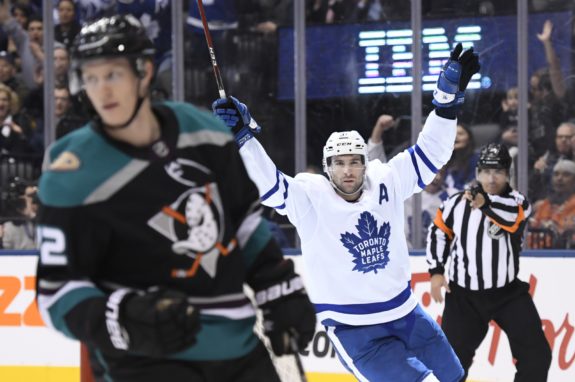
John Tavares (THE CANADIAN PRESS/Nathan Denette) 
Auston Matthews (THE CANADIAN PRESS/Nathan Denette)
After 77 games for Tavares and 64 games for Matthews, their average goals per game are nearly identical. Tavares’ average is 0.577 and Matthews’ is 0.578. The benchmark is 0.61 goals per game. Based on current rates of output, each player needs to score 3 more goals per season.
Related: Tavares’ Quest for 50
Historically, 31 percent of 50-goal scorers’ goals are scored on the power play. Using the percentage, the hard number benchmark is 16 power play goals.
Tavares’ current power play production is 11 percent below the benchmark. He’s currently at nine power play goals and may get to 10. It should be noted though; a measure of even strength goals would show Tavares ahead of the average. The take away, average goals per game is the most important indicator. As long as any dip in one is offset by an increase in the other, Tavares matches up well with the benchmarks.

Matthews’s current PPG production (32.4 percent of goals scored) is higher than the benchmark of 31 percent.
The current average time on ice for Tavares and Matthews are below the benchmark of 22:28.
From a historical perspective, they need coach Mike Babcock’s cooperation to give them the time on ice minutes they theoretically need to score 50-goals.
Tavares’ average time on ice per game is 19:07. He averages 24.1 shifts per game. Using his average shift length of 47.47 seconds, Tavares needs four more shifts per game to get to the benchmark.
Matthews’ average time on ice per game is 18:28. He averages 23.4 shifts per game. Using his average shift length of 46.87 seconds, Matthews needs five more shifts per game to get to the benchmark.

The benchmark number of shots per season for a 50-goal scorer is 302. Based on an 82-game season, 3.68 shots per game is the benchmark.
Tavares’ current average is 3.47 shots per game, very close to the benchmark. His projected 285 shots for this season must increase by 17 shots, or one shot every five games.
Matthews’ current average is 3.67 shots per game, nearly even with the benchmark.
Can Tavares & Matthews Score 50 in Same Season?
It’s doable. It is a very exciting time to be a Maple Leafs fan.
Visions of greatness prevail. Will the future success many foresee for the Maple Leafs include Tavares and Matthews scoring 50 goals each in the same season?
If they do, it will be the first time a duo of
The suggestion here is they will do it. However, the best before date on this forecast is the 2021-22 season. It must happen next season or the season after.